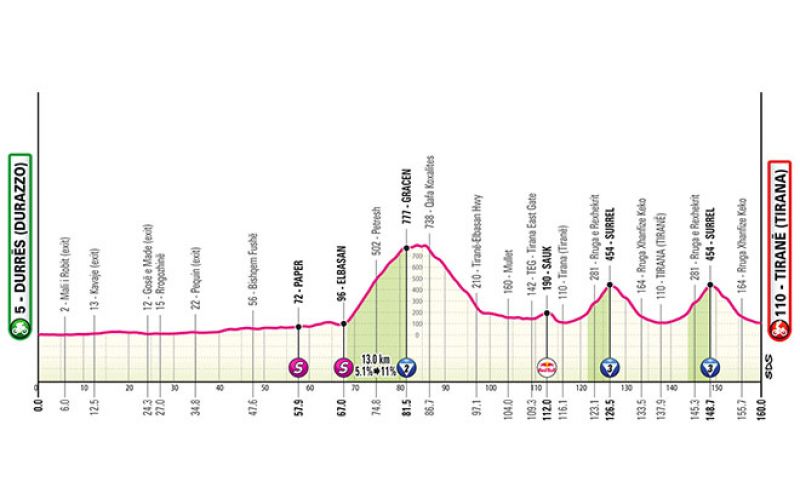

Durazzo is writing a new page in history, hosting the start of the 108th Giro d'Italia, the first one starting from Albania, the 15th edition starting outside national borders. The first stage leads to the finish line in Tirana, the capital, after a 160 km route that is anything but simple.
to follow the live coverage of the entire stage starting at 1:10 PM CLICK HERE
Gateway to Albania, Durazzo combines history and modernity. Ancient Roman ruins, like the Amphitheater, overlook the Adriatic Sea, creating a fascinating contrast with the vibrant and modern waterfront. The Castle, with its imposing walls, offers a panoramic view of the city and the sea, while the historic center, with its narrow streets and stone houses, preserves an authentic atmosphere.
As we mentioned, the stage is far from simple: after a flat and calm start, around km 65 the climbing begins: in this first part, there are two intermediate sprints at Paper (km 57.9) and Elbasan (km 67). Riders will face the Gracen climb (13 km at 5.7%, which will be the first mountain grand prix of the pink race) before reaching Tirana and entering the final circuit just after the arrival. They will cover almost the entire circuit of about 22 km before passing the finish line and completing a full lap. They will climb the Surrel climb twice, 6.9 km at 4.6% but with gradients reaching 13% in the first part: in both cases, mountain points will be awarded at the summit.
After the final descent, wide city streets, last 3 km slightly downhill until the last kilometer and a perfectly flat final straight where the first pink jersey will be awarded.
THE TERRITORY. The Venetian Tower is the most evocative observation point for the Giro d'Italia's start, which for the first time travels the roads of Albania. Built in the 15th century to enhance the defensive system of the Byzantine Castle, it is 10 meters high and from its top offers a privileged view of the Ionian Sea and the city of Durazzo. Which has much to offer. Starting from a historic center where it's pleasant to wander through alleys and stone houses, contrasting with the well-organized and lively waterfront.
Durazzo's history, strategically positioned on the western shore of the Ionian, is very ancient. Founded by Greeks in the 7th century BC and subsequently developed by Romans and Ottomans, Durazzo tells its story through its rich archaeological and architectural heritage. One of the city's symbols is the Roman Theater, built in the 2nd century AD, one of the largest in the Balkans, which once hosted up to 20,000 spectators. Next to it, the Archaeological Museum collects artifacts from Greek, Roman, and Byzantine eras, offering a glimpse into the millennial history of the city and the region. Also worth seeing is the Fatih Mosque, dedicated to Sultan Mohammed II the Conqueror and built in 1502 following the establishment of Ottoman rule, and the Byzantine Forum with its fascinating series of Corinthian columns that constituted the so-called Macellum (market) of the post-Roman era. It dates back to the period between 600 and 800 and is paved with marble stones.
Leaving the coast, the Giro heads inland, southward, crossing flat countryside to the foot of the Gracen climb, the first mountain grand prix of the Pink Race. Before starting the climb, however, it's worth making a very brief detour to get to know the city of Elbasan, with its castle, built by the Ottomans in the 15th century on the ruins of a fortress already built in Roman times.
The route returns briefly to the plains to reach Tirana for the first time, where the riders enter the final circuit that includes two ascents of Surel, a tiny hill settlement, a pleasant excursion destination especially when temperatures start to rise. Ten kilometers of descent lead to the finish in Tirana, the capital, which will be dedicated to the entire next day of the Giro.

Se sei giá nostro utente esegui il login altrimenti registrati.